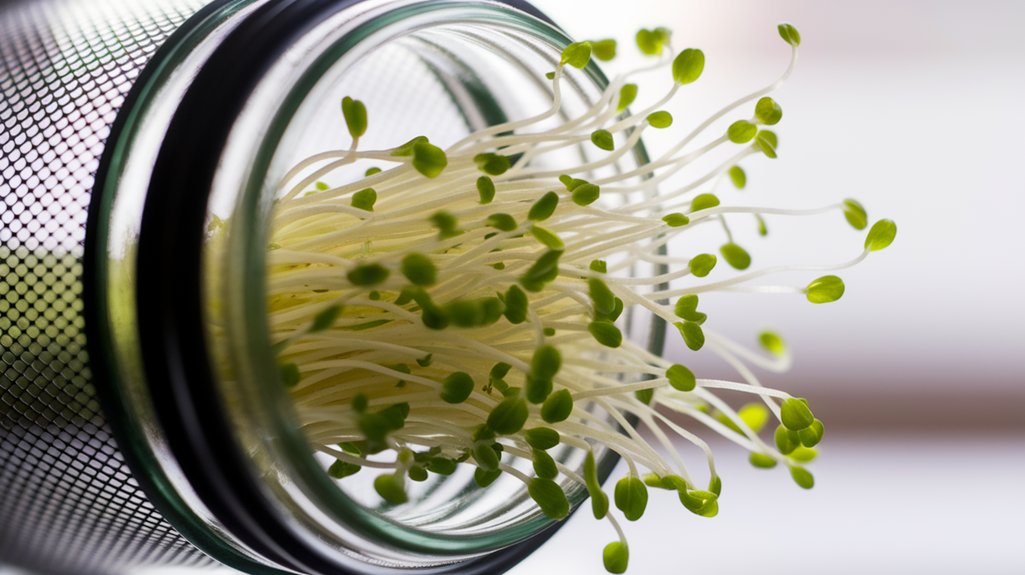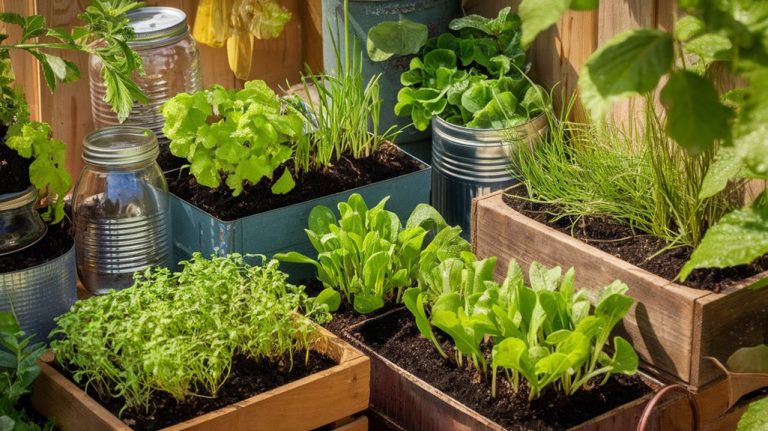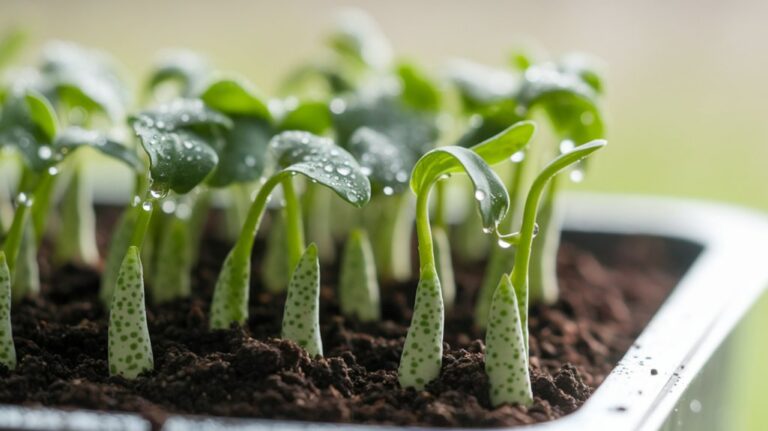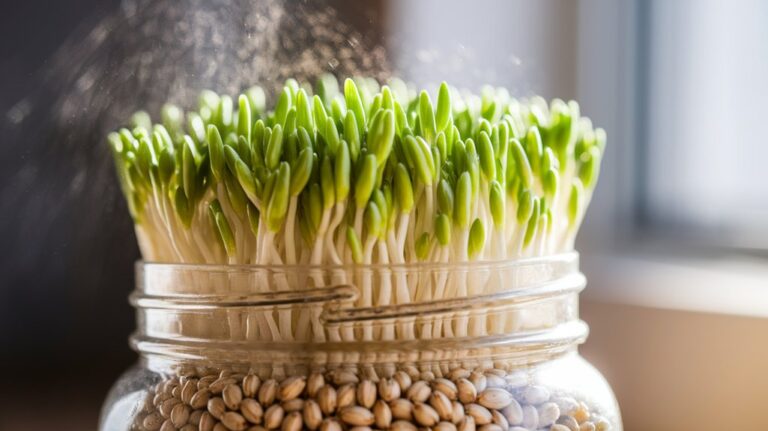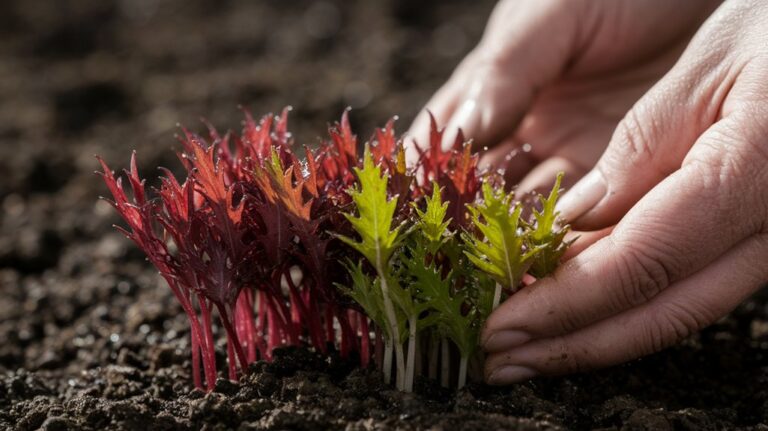How to Sprout Lentils
To sprout lentils, I start by selecting high-quality green or brown lentils, preferably organic. I rinse them thoroughly and soak them in water for about 8 hours. After soaking, I drain and place them in a sprouting jar, rinsing them twice daily. In just a few days, I see tiny tails developing. Once they’re ready, I give them a final rinse and can easily incorporate them into salads or bowls. You’ll love how simple it is!
Key Takeaways
- Start with high-quality, whole green or brown lentils, preferably organic, for better sprouting success.
- Rinse lentils thoroughly before soaking to remove dust and impurities.
- Soak lentils in water for about 8 hours, then drain and rinse again.
- Place drained lentils in a sprouting jar, rinsing them twice daily for hydration.
- Harvest sprouted lentils after 4 to 6 days, rinsing and storing them in the fridge for use.
Selecting the Right Lentils
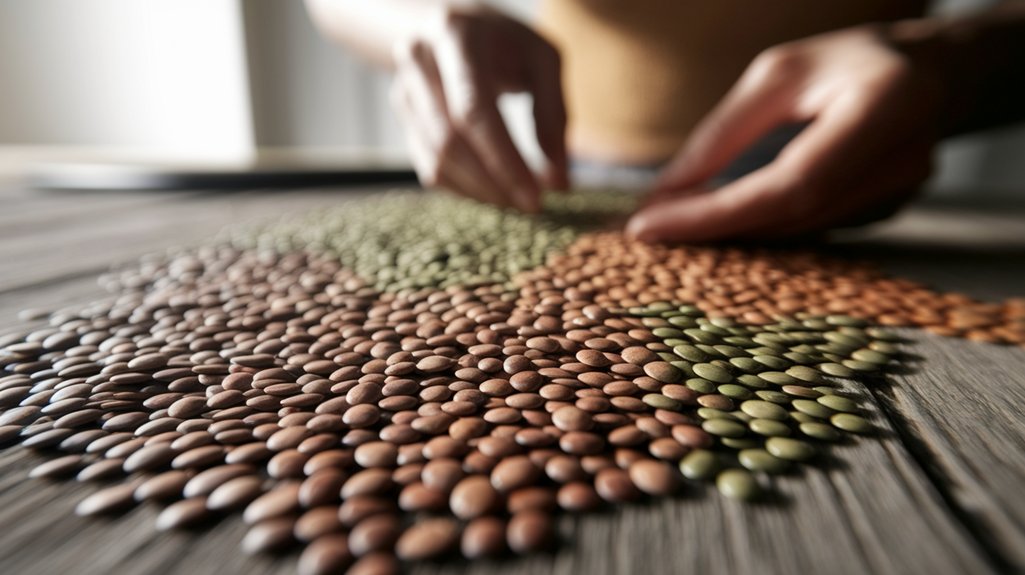
When I set out to sprout lentils, I’ve found that choosing the right type is crucial for success. Green and brown lentils are my go-to varieties because they sprout quickly and have a mild flavor.
I prefer organic lentils, as they’re less likely to be treated with chemicals that could hinder sprouting. Avoid split lentils, as they don’t sprout well. It’s also important to check for freshness; older lentils may have reduced viability.
I recommend purchasing from reputable sources to ensure quality. By selecting the right type, I’ve consistently achieved great results, and my homegrown sprouts have added nutrition and crunch to my meals.
Preparing Lentils for Sprouting
To prepare lentils for sprouting, I always start by selecting high-quality seeds, as this can significantly impact the success of the sprouting process.
After choosing the right lentils, I rinse them thoroughly to remove any dust or impurities and then soak them in water for several hours.
This simple preparation sets the stage for healthy and vibrant sprouts.
Selecting Quality Lentils
Choosing the right lentils is crucial for successful sprouting, as their quality directly impacts the outcome. When I select lentils, I look for whole, unbroken seeds without any signs of damage or discoloration.
Avoid those with a stale smell or any off-putting odor, as these can indicate spoilage. Opt for organic lentils, if possible, to reduce the risk of pesticide residues.
I also check for the packaging date; fresher lentils generally sprout better. If you can, buy them from a reputable source or bulk bins, ensuring they’re stored properly.
Rinsing and Soaking
After selecting high-quality lentils, the next step is rinsing and soaking them properly.
I start by placing the lentils in a fine-mesh strainer and rinsing them under cold water for about a minute. This helps remove any dust or impurities.
Once rinsed, I transfer them to a bowl and cover them with enough water to submerge the lentils completely. I let them soak for 8 to 12 hours; this softens the lentils and kickstarts the sprouting process.
It’s essential to keep the bowl in a cool, dark place to prevent fermentation. After soaking, I drain the lentils again and rinse them, preparing them perfectly for the next step in the sprouting journey.
Happy sprouting!
Rinsing and Soaking Lentils
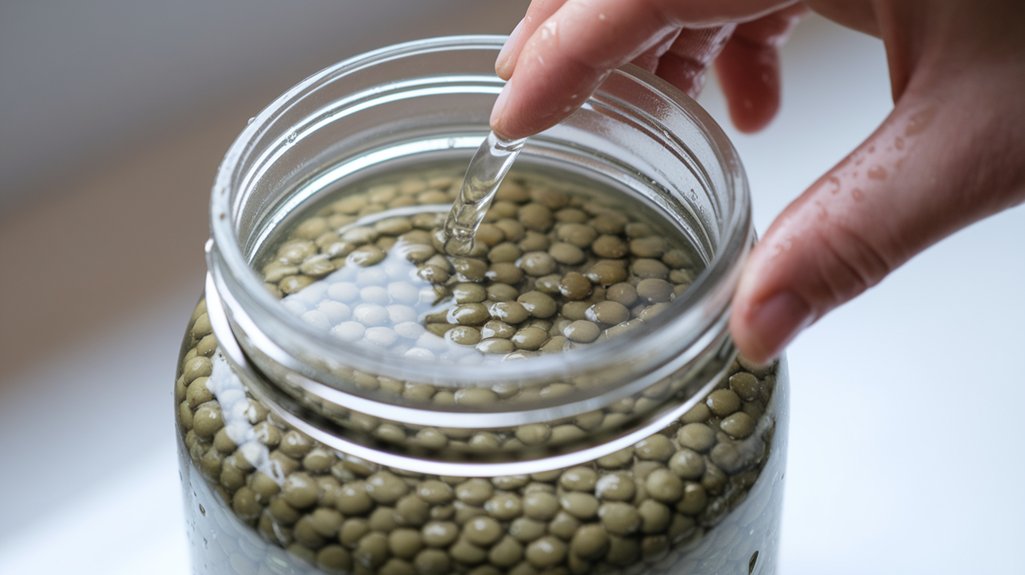
Rinsing and soaking lentils is a crucial step in the sprouting process, and it only takes a few minutes to get it right.
First, I measure out the lentils I want to sprout and place them in a fine-mesh strainer. I rinse them under cold running water, removing any debris or dust. This step ensures the lentils are clean and ready for soaking.
Next, I transfer the rinsed lentils to a bowl and cover them with water, allowing them to soak for about 8 hours or overnight. This soaking softens the lentils, kickstarting the sprouting process.
After soaking, I drain the water, setting the stage for the next steps in sprouting, ensuring a healthy and nutritious outcome.
Draining and Sprouting Process
Once I’ve drained the soaked lentils, the sprouting process can begin. I place the lentils in a sprouting jar or a mesh colander, ensuring good air circulation. Next, I rinse the lentils with fresh water twice a day. This keeps them hydrated and helps avoid mold.
Here’s a simple chart to track my sprouting progress:
| Day | Action | Notes |
|---|---|---|
| Day 1 | Rinse & Drain | Lentils should be moist |
| Day 2 | Rinse & Drain | Tiny tails may begin to form |
| Day 3 | Rinse & Drain | Sprouts should be visible |
| Day 4+ | Rinse & Drain | Continue until desired length |
Maintaining Optimal Conditions
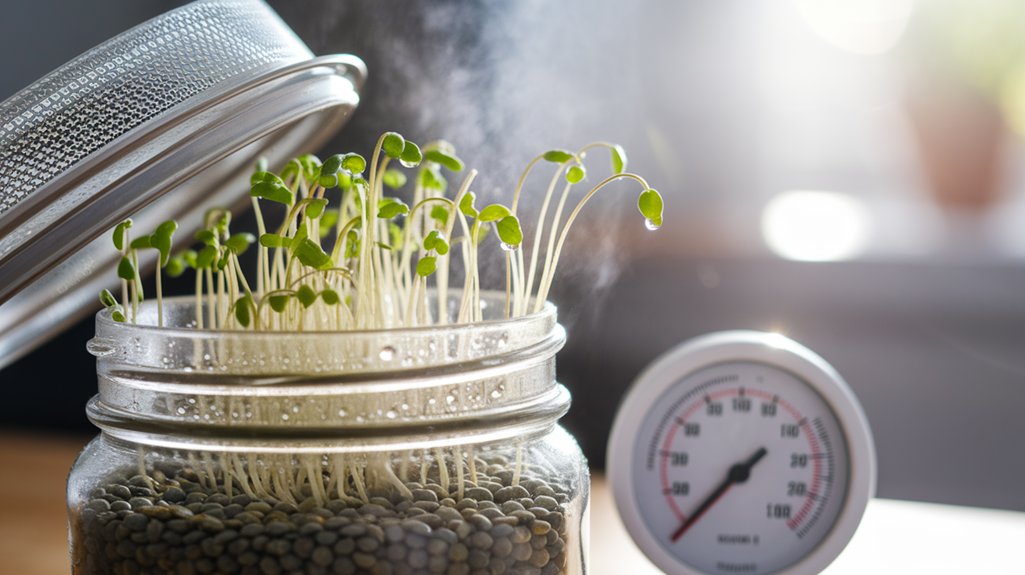
To ensure my lentils sprout successfully, I focus on maintaining optimal conditions throughout the process. Here are three key factors I pay attention to:
- Temperature: I keep my lentils in a warm spot, ideally between 68°F to 75°F (20°C to 24°C). This temperature range promotes faster sprouting.
- Moisture: I make sure my lentils remain damp but not soaked. Too much water can lead to mold, so I rinse them twice a day to keep the moisture just right.
- Light: I avoid direct sunlight as it can heat up my lentils too much. Instead, I place them in a well-ventilated area with indirect light, fostering a balanced environment for sprouting.
Harvesting Your Sprouted Lentils
After about 4 to 6 days of sprouting, I can tell my lentils are ready to be harvested when they’ve developed small, tender shoots.
At this point, I gather my sprouted lentils and rinse them thoroughly under cool water to remove any residual hulls or debris. It’s important to handle them gently to avoid damaging the delicate shoots.
I then drain them well and spread them out on a clean kitchen towel to dry. Once they’re dry, I store the sprouted lentils in an airtight container in the fridge.
They can last for up to a week, but I love using them fresh for the best flavor and texture.
Enjoy the satisfaction of harvesting your homegrown sprouts!
Incorporating Sprouted Lentils Into Meals
I love incorporating sprouted lentils into my meals because they add a nutritious crunch and boost the protein content.
They make fantastic toppings for salads or can be mixed into grain bowls for extra texture.
Plus, I often snack on them straight from the jar for a healthy, satisfying option.
Salad Toppings and Mix-ins
While sprouted lentils add a nutritious crunch to salads, they also serve as a versatile base for a variety of toppings and mix-ins.
I love experimenting with different flavors and textures. Here are three of my favorite additions:
- Fresh Herbs: Chopped cilantro, parsley, or basil brighten up the dish and enhance its nutritional profile.
- Vegetables: Diced cucumbers, bell peppers, or shredded carrots provide extra crunch and vitamins, making my salad more satisfying.
- Dressings: A simple lemon-tahini dressing or a balsamic vinaigrette elevates the flavors and ties everything together.
These toppings not only complement the sprouted lentils but also make my salads more enjoyable and nourishing.
Give them a try, and you might discover your new favorite salad combination!
Healthy Snack Options
Sprouted lentils make an excellent addition to healthy snacks, offering a nutritious boost that’s both filling and flavorful.
I love adding them to hummus for a protein-packed dip, perfect for pairing with veggies or whole-grain crackers. You can also toss sprouted lentils into a smoothie for added fiber and nutrients; they blend seamlessly and enhance the texture.
For a quick snack, I mix them with nuts and seeds for a crunchy trail mix. Alternatively, try sprinkling them on avocado toast for extra crunch and nutrition.
Incorporating sprouted lentils into your snacks not only elevates flavor but also supports your health goals, making it an easy choice for nutritious eating.
Frequently Asked Questions
Conclusion
In conclusion, sprouting lentils is an easy and rewarding process that enhances their nutritional value and flavor. By selecting the right lentils, properly rinsing and soaking them, and maintaining optimal conditions, I’ve found that I can enjoy fresh sprouts in just a few days. These nutritious additions can elevate a variety of dishes, from salads to sandwiches. So, why not give it a try? You’ll be amazed at how simple it is to incorporate sprouted lentils into your meals!

